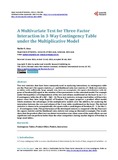A multivariate test for three-factor Interaction in 3 - way contingency table under the multiplicative model

View/
Date
2014-06-16Author
Ama, Njoku O.
Publisher
Scientific Research Publishing IncRights
This work is licensed under the Creative Commons Attribution International License (CC - BY)Rights holder
The author and Scientific Research Publishing Inc, http://www.scirp.orgType
Published ArticleMetadata
Show full item recordAbstract
Abstract
Two test statistics that have been commonly used in analysing interactions in contingency table are the Pearson’s Chi-square statistic, χ2, and likelihood ratio test statistic, G2. Both test statistics, in tables with sufficiently large sample size, have an asymptotic chi-square distribution with degrees of freedom (df) equal to the number of free parameters in the saturated model. For example under the hypothesis of independence of the row and column conditioned on the layer in an I × J × K contingency table, the df is K(I − 1)(J − 1). These test statistics, in large sized tables, will have less power since they have large degrees of freedom. This paper proposes a product effect model, which combines the advantages of the multiplicative models over the additive, for analysing the interaction between the row and column of the 3-way table conditioned on the layer. The derived statistics is shown to be asymptotically chi-square with a small degree of freedom, K − 1, for the I × J × K contingency table. The performance of the developed statistic is compared with the Pearson’s chi-square statistic and the likelihood ratio statistic test using an illustrative example. The results show that the product effect test can detect interaction even when some of the main effects are not significant and can perform better than the other competitors having smaller degree of freedom in large sized tables.
